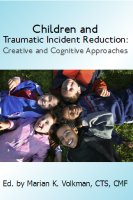Children and Traumatic Incident Reduction: Creative and Cognitive Approaches

What if we could resolve childhood trauma early, rather than late?
We are understanding more and more about how early traumatic experiences affect long-term mental and physical health:
- Physical impacts are stored in muscles and posture
- Threats of harm are stored as tension
- Overwhelming emotion is held inside
- Negative emotional patterns become habit
- Coping and defense mechanism become inflexible
What if we could resolve childhood trauma before years go by and these effects solidify in body and mind?
In a perfect world, we’d like to be able to shield children from hurt and harm. In the real world, children, even relatively fortunate ones, may experience accidents, injury, illness, and loss of loved ones. Children unfortunate enough to live in unsafe environments live through abuse, neglect, and threats to their well-being and even their life.
What if we could resolve childhood trauma fully, gently, and completely while the child is still young?
We Can. Read Children and Traumatic Incident Reduction and find out how!
“This book is a must for any therapist working with kids. Naturally, it focuses on the approach of Traumatic Incident Reduction, but there is a lot of excellent material that will be useful even to the therapist who has never before heard of TIR and may not be particularly interested in learning about it. The general approach is respectful of clients, based on a great deal of personal experience by contributors as well as on the now extensive research base supporting TIR, and fits the more general research evidence on what works”. —Robert Rich, PhD
Book #2 in the TIR Applications Series. Series Editor: Robert Rich, PhD
Learn more about TIR books at www.TIRbook.com
Traumatic Incident Reduction (TIR) is a brief, person-centered therapy for resolving symptoms of traumatic stress (acute and chronic) including Post-Traumatic Stress Disorder (PTSD). TIR facilitators around the world engage with diverse populations including crime victims, domestic violence survivors, children, natural disaster survivors, accident victims, and combat veterans.
These practitioners include psychologists, social workers, ministers, domestic violence counsellors, and lay practitioners who work in various settings such as hospital clinics, private practices, shelters, victim services agencies, and disaster sites.